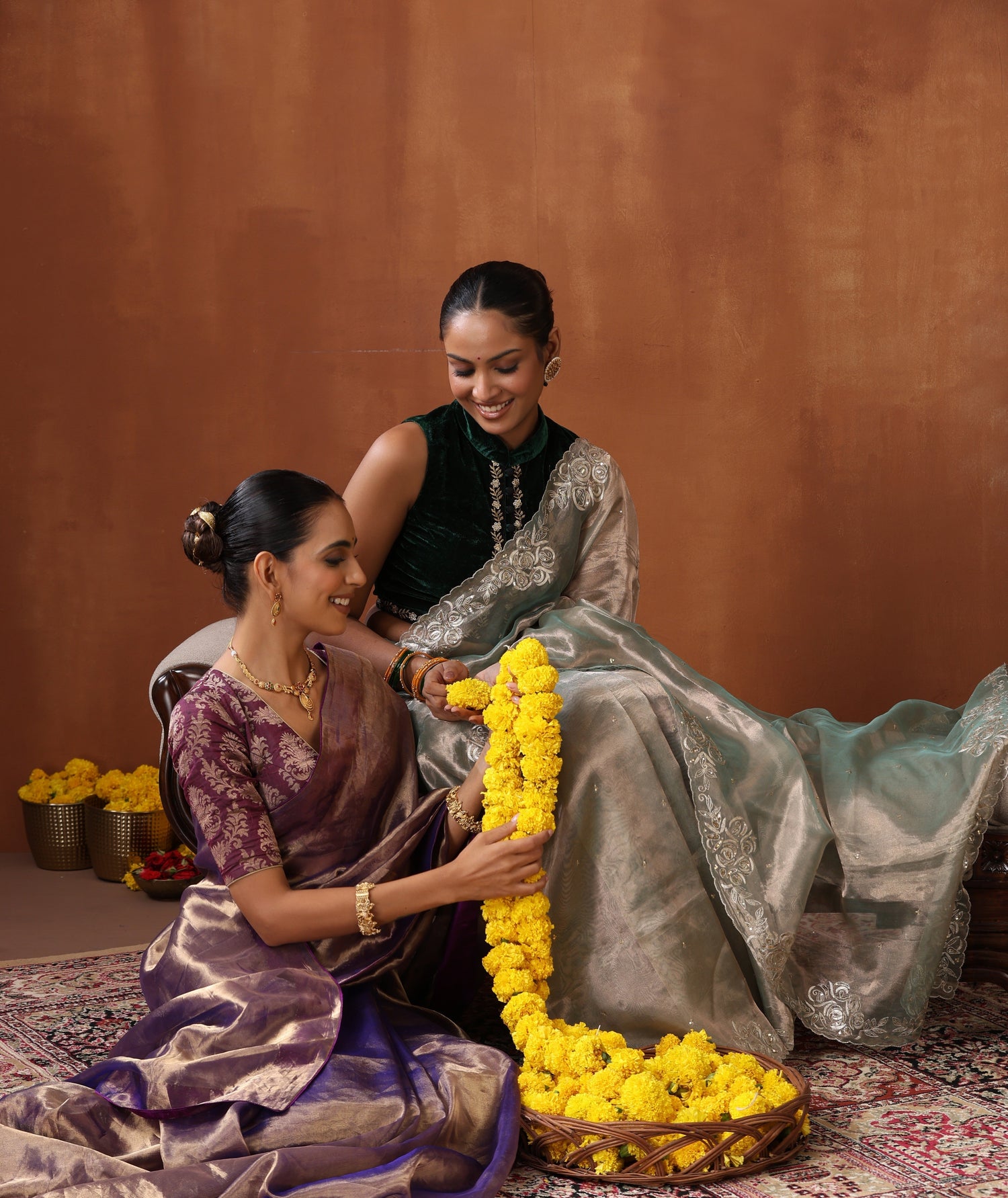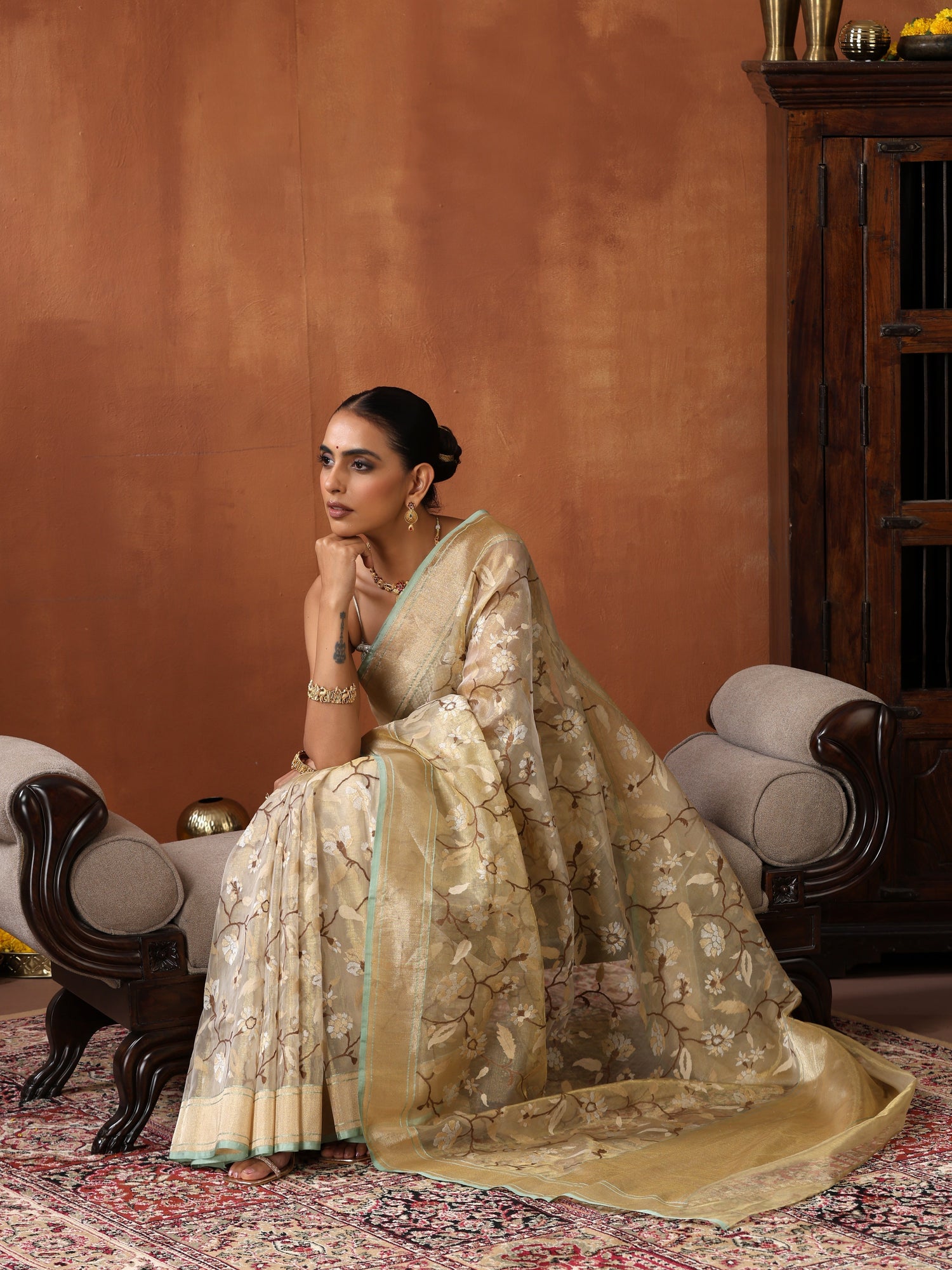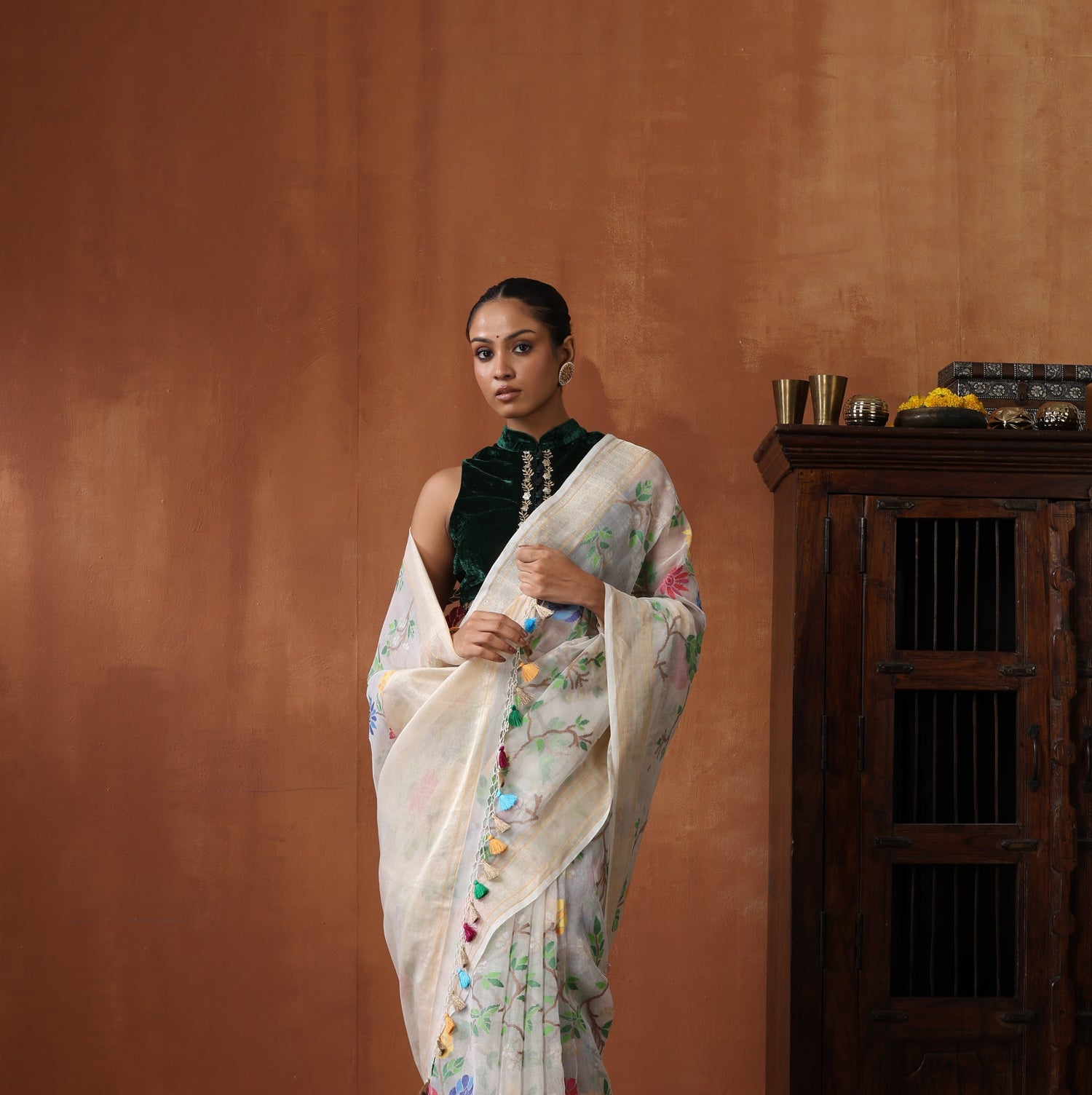‘The hand-woven fabric’ is symbolic of man’s endeavour to bring beauty and grace into life, which is otherwise severely constrained by standardization and the consequent monotony. The rich and beautiful products of the weavers of India have been rightly called ‘exquisite poetry in colourful fabrics’ (Mehta, 1970).
The loom is one of the oldest and most enduring symbols of our civilization. Because it is so old, people tend to forget that it is also a kind of machine, albeit one that relies very heavily on the skills of the human hand. There is a special relationship between the weaver, his loom and the woven cloth.
Every piece of handloom cloth sold, goes a long way to provide a square meal to a hungry weaver. Every piece is often different from the other, a symbol of his workmanship and it testifies to the art and tradition of the craftsmanship. It is not mass produced and hence it is not a stock reprint (Naik, 1997)
Fascinating motifs and super design of the fabric assign special importance to this industry. The etymology of the word ‘Saree’ is from Sanskrit, the word ‘Sati’, which means a strip of cloth. In Sanskrit saree is also called ‘Chira’ (Dar, 1982). This evolved in to the Prakrit ‘Sadi’ and was later anglicized into ‘Sari’ (http://www.exoticindia.com). The Indian sari is a made-up fashioning the female form is known by different names in various Indian languages; in Hindi, Gujrati, Bengali, Bihari and Oriya, it is known as ‘Saadi’; in Marathi ‘Sadi’; in Kannada ‘Seere’; in Telugu as ‘Sheera’ and Tamil as ‘Podavi’
A charming folktale explains the origin of the saree as; “The sari, it is said, was born on the loom of a fanciful weaver. He dreamt of women, the shimmer of her tears, the drape of her tumbling hair, the colour of her many moods, the softness of her touch, all he wove together non stop. Finally he made many yards. Further the story ended mentioning that he sat at the back of the loom and smiled and smiled and smiled
The famous writer Ruskin Bond said that “Uttar Pradesh is the rainbow land where the multi-hued Indian culture has blossomed from time immemorial. It is blessed with a variety of geographical land and much cultural diversity. But it is a world in itself”. The silk sarees of Uttar Pradesh are unique and distinctive in yarn type, weave, colour, motif, finish and texture. The most expensive of woven sarees are the Indian silk sarees and the best example is the quintessentially Hindu wedding saree-the ‘Banaras saree’.
Banaras prevents a classical art heritage of India in the form of gorgeous and fascinating brocades assimilating the spirit and traditions of several ages since the Vedic period. Ethnic Banarasi brocades are the finest example of superb craftsmanship of Indian artisans. Rich in colours and patterns interwoven with gold/silver threads are the living embodiment of the skills of our craftsmen, developed, nurtured and perfected over the Centuries.
The Vedic texts, Rig-Veda, dating as far back as 1500 BC to 500 BC have referred to the ‘Tantuvayas’ or weavers who used to make cloths of various kinds such as cotton, silk and brocades. During these times, brocades were known as ‘Hirayana’. The reference of ‘Kasika vastra’ or ‘Kasiyani’ with reference to exquisite fabrics may easily be traced in Jatakas and writing of Kautilya and Patanjali. In Ramayana, mentioned about the Ravana who wore brocade cloths (Thomas, 1985).
Ralph Fitch, an English traveler who visited Varanasi in 1583 described of the fabric being “fine as the filmy webs and spider weavers”.
Francois Bernier, a French physician, visited India during the region of Shah Jahan, figured Banaras as an outstanding centre of textile manufacture in the very early stage of Indian culture and said
‘Banaras is the Athens of India’
If the ‘Banarasi Pan’ is an irresistible delicacy to men, certainly, the ‘Banarasi silk saree’ is a delicacy to women. The ethnic designs of Banarasi silk sarees are in fact, an obsession even to the fashion-conscious women of today. And not surprisingly, these sarees have registered an ample demand in foreign markets and earned substantial foreign exchange.
Some of the popular names of sarees originating from the Banaras retail market are –Brocade saris, Jangala, Satin border, Tanchoi, Meenabuti, Satin Ambos, Tissue, Crepe, Resham buti, and Cutwork sarees.
The Indian fabric of dream is Banaras brocade, which is literally a cloth of gold. The term ‘Brocade’ is derived from the Latin world brocare (to prick), which means needlework or often defined as embroidery weaving or loom embroidery. Banaras brocade is also known as ‘kinkhab’ or ‘kamkhwab’ means kin (golden), khab (dream); a golden dream or kam (scarcely), khwab (dream); a fabric seldom or rarely seen in dream. It is heavy, woven with all over gold thread. The traditional Banaras brocades were classified into three following groups viz. Zari brocades (Kinkhab and Baftas/ poth-thans), Amru brocades (silk patterns on silk i.e. tanchoi) and Abirawans (Cut work brocades and Tarbana).
The gold and silver zari are used to create glittering embossed extra weft pattern that gave a classic touch to the saree. Various types of zari are.
a) Pure zari: This is also known as real zari. The centre core of pure zari is made up of degummed twisted red or yellow mulberry silk yarn; over which silver lametta and badla (flatten wire) is wound. The silver zari threads are electroplated with pure gold solution, to produce gold zari.
b) Tested zari: It is also called imitation zari because it has the external features of real zariand thus, resembles the real zari in terms of shine. This variety is similar to real zari except copper lametta used in place of silver and silver gilding is done on copper wire. For gold zari, the tested zari is electroplated with gold solution.
c) Powder zari: The manufacturing process of powder zari is similar to tested zari, where in powder gilding is done on imitation zari in place of gold gilding.
d) Plastic zari: The manufacturing process is more or less same as other varieties. In this variety plastic thread is used as lametta instead of copper or silver.
The Banaras silk sarees are woven on throw shuttle pit looms by single person but for intricate designs, he/she needs a helper. Saree weaving is accomplished by using one big throw shuttle carrying weft yarn for ground fabric and many tiny shuttles or pirns carrying silk or zari thread for extra weft designs. During weaving process, the weaver sprinkles water on warp sheet (Tana) occasionally with the help of abgir (a broom-like instrument) to maintain its elasticity, failing which, it would lead to yarn breakage due to dryness. Thus the Sari is woven with great care and patience
Taking up and letting off
The completion of sari is called reja pujna. The woven cloth (Than or Reja) is taken up and wound on the cloth beam (Tur) and the process is called taking up. The woven fabric,when taken off from the loom is called a kora than, the pure fabric. During letting off, the warp yarns are released from warp beam (Bhanjni) as and when the woven cloth is taken up.
Cutting and doffing the saree
After completion of each saree an extra length of approximately one inch is woven and separated from the cloth beam with the help of knife. This however, helps to prevent the slippage of yarns through the dents. Extra length of eight to nine inches of warp sheet is left at the back of the harness to which warp ends of new saree will be twisted, glued and joined.
Motifs Used In Banaras Silk Sarees
The motifs used in Banaras silk sarees are galaxy of designs of various sizes and shapes, which are exotic, exquisite, splendid and sturdy. Decorative floral pattern, vegetal designs, geometrical motifs, stylized dots, asharfi motifs, small flower buttas (buti), jal patterns, kalgha motif (mango motif), human figures, animal and bird depictions and so on drawn from the nature, the tree of life.
Banaras silk saree is known for its softness, gleam, grandeur and luxurious look. The saree achieves royal look through its rich and intricate weave and zari work.
The variegated patterns of Banaras silk sarees are :
Brocade saree – The term brocade refers to those textiles, where patterns are created in weaving by transfixing or thrusting the thread pattern between the warp. The saree has floral motifs in gold and silver threads, used as extra weft against silk ground. The body of the saree has all over pattern whereas border and pallav have scroll designs.
Chiffon Jamdani saree – Hard twisted yarns formed the warp sheet. The S and Z twisted ends are arranged alternately, that produce a wavy and crepe appearance. The sarees commonly have all over buti patterns.
Jangla saree – These are very rich wedding sarees. All over jal and jangla designs are used to produce stylized appearance and further decoration was made with meena work. The motifs resemble like thread work since appear identical on both sides (swivel weave), without floats. Jangla saree is woven with two weavers who work together with 14-28 shuttles at a time.
Kora cutwork saree – It is a typical saree produced with cut work against plain ground. The extra loosely dangling threads between the motifs are trimmed manually, giving a jamdani effect
Resham buti saree – A rich kind of Banaras silk saree has butis on allover ground with heavy design on border and pallav.
Satin border saree – The saree is plain with border and pallav in satin weave.
Satin embossed saree – The sarees are woven in satin weave that have all over floralilayecha and charkhana patterns.
Tanchoi saree – Three sarees are without zari and the motifs are woven in satin weave with silk as extra weft. The minute diaper of jamawar style and paisley motifs are spread densely on the ground of the saree. In other words the designs are visible on face of the Saree.
Tissue saree – These sarees are woven with silk as warp, zari running as weft with combination of zari and silk in extra weft. Therefore the tissue sarees appear almost like gold cloth and are most popular as wedding sarees
Reference Credit : Ms. Amrita Singh.
http://www.toursnorthindia.com
http://in.geocities.com/artsvaranasi/abtvns.html
http://www.varanasicity.com/index.html









